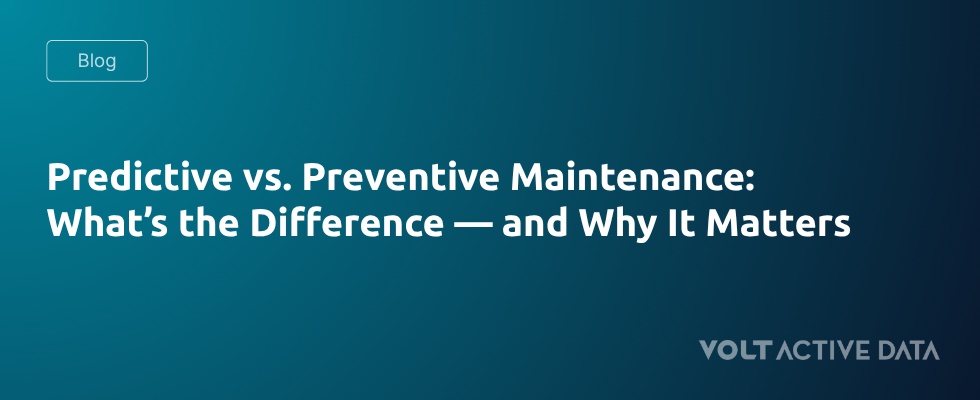Key Takeaways
- Preventive maintenance is a scheduled approach involving routine inspections and part replacements at set intervals.
- Predictive maintenance uses real-time data to assess equipment condition and forecast when maintenance is needed, leveraging sensors and analytics.
- Preventive maintenance is simpler to plan but may result in unnecessary maintenance or miss issues, while predictive maintenance requires investment in data platforms but minimizes downtime and costs.
- Preventive maintenance is ideal for low-complexity assets, while predictive maintenance is best for critical or high-value assets.
- A combination of both preventive and predictive maintenance is often the best strategy, starting with preventive and evolving into predictive as systems mature.
Maintenance strategies can make or break operations—literally. For organizations relying on industrial equipment, understanding the difference between preventive, or preventative maintenance, and predictive maintenance is crucial to avoiding costly downtime, maximizing asset lifespan, and improving operational efficiency.
Unfortunately, these two terms are often used interchangeably, which causes confusion.
Let’s clarify them.
Table Of Contents
What Is Preventive Maintenance?
Preventive maintenance is a scheduled, proactive approach to maintenance. It involves routine inspections, servicing, and part replacements at set intervals—based on time, usage, or manufacturer recommendations—regardless of the actual equipment condition.
Think of it like getting your car’s oil changed every 5,000 miles whether it needs it or not.
Benefits:
- Reduces likelihood of unexpected breakdowns
- Simpler to plan and manage
- Doesn’t require real-time data infrastructure
Drawbacks:
- May result in unnecessary maintenance
- Can miss issues that arise between intervals
- Doesn’t account for variability in real-world usage or environmental conditions
What Is Predictive Maintenance?
Predictive maintenance (PdM), on the other hand, uses real-time data to assess equipment condition and forecast when maintenance is actually needed. It leverages sensors, machine learning, and advanced analytics to detect early warning signs of failure.
This strategy is about fixing the machine before it breaks—but only when it shows signs of needing attention.
Benefits:
- Minimizes unplanned downtime
- Reduces labor and materials costs by avoiding unnecessary work
- Extends asset lifespan with less disruption
Drawbacks:
- Requires investment in real-time data platforms that can do real-time decisioning, sensors, and analytics tools
- More complex to implement
- Best suited for high-value or mission-critical systems
Preventive vs. Predictive Maintenance: At a Glance
| Type | Preventive Maintenance | Predictive Maintenance |
| Trigger | Scheduled (time/usage) | Real-time condition |
| Data Dependence | Low | High (sensors, analytics) |
| Cost Efficiency | Medium | High |
| Failure Risk | Medium | Low |
| Implementation | Simple | Complex |
| Ideal For | Low-complexity assets | Critical/high-value assets |
Real-World Example
Let’s say you operate a manufacturing plant with hundreds of motors. With preventive maintenance, you might service each motor every three months. But what if some motors barely run while others operate 24/7? That approach wastes time and resources—and still risks failure.
With predictive maintenance, sensors monitor vibration, temperature, and load in real time. If one motor starts behaving abnormally, maintenance is triggered only for that asset, exactly when it’s needed.
Which Strategy Is Right for You?
- Choose preventive maintenance if your assets are inexpensive, easy to service, or don’t justify the cost of real-time monitoring.
- Choose predictive maintenance if downtime is expensive, asset longevity is critical, and you want to optimize efficiency.
In most modern industrial environments, the best strategy is a combination of both—starting with preventive maintenance and evolving into predictive as your systems mature and your data capabilities grow.
Why Volt Active Data for Predictive Maintenance
Predictive maintenance is only as good as your data platform. To make it work, you need to ingest, process, and act on real-time streaming data at massive scale and low latency.
That’s where Volt Active Data comes in. Volt enables predictive maintenance by:
- Ingesting high-volume sensor data in real time
- Performing complex condition checks and anomaly detection in milliseconds
- Triggering automated maintenance workflows without delay
Want to see how Volt powers predictive maintenance for next-gen industrial systems? Contact us or explore our Predictive Maintenance solution page.




